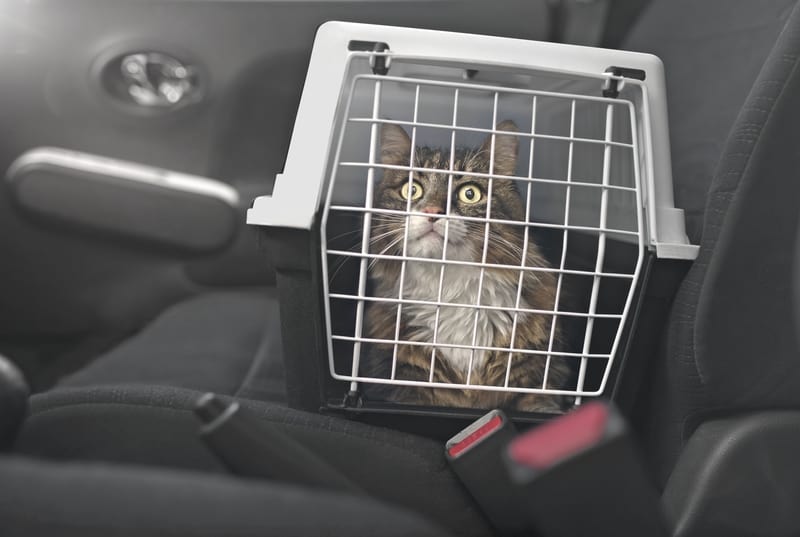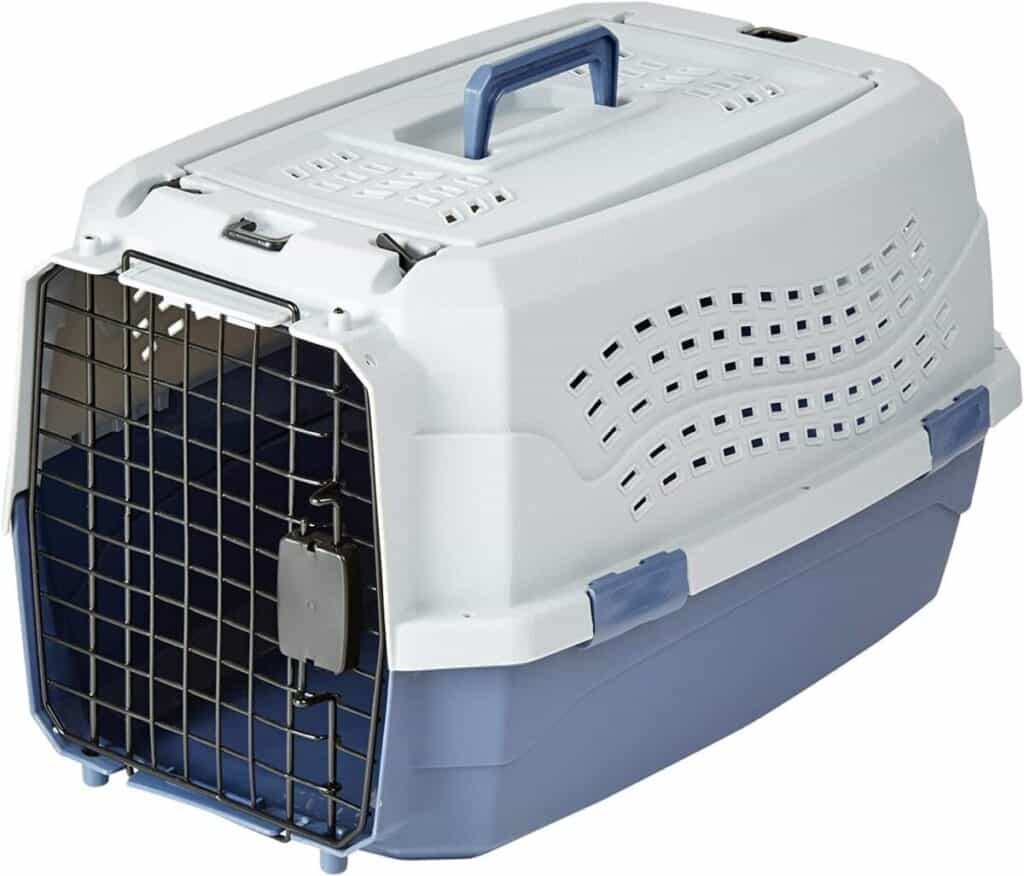It’s no secret that cats aren’t the biggest fans of car rides. However, it can’t always be avoided. Plus, if you start training your cat early enough, they could learn to love life on the road.
In addition to dozens of vet visits over the years, I’ve traveled across the United States (from the Appalachian mountains to the Rockies and back) four times with my three cats in the car.
In this article, I’ll share my absolute best tips for traveling with a cat in the car from choosing the right cat carrier to preparing your cat for travel to common problems and questions you may have on the road.
Table of Contents:
- How To Prepare Your Cat for Car Travel
- Tips for Traveling With a Cat in the Car
- How To Travel Long-Distance With Your Cat
- How To Reduce Your Cat’s Travel Anxiety
- Why Is My Cat Panting in the Car?
- The Best Cat Carriers & Other Cat Travel Essentials
How To Prepare Your Cat for Car Travel
Before you actually drive anywhere with your cat, there are a few things you can do to prepare. This will help make the trip less stressful for both you and your cat.
Before the day of the drive, here’s everything you should do to prepare your cat for car travel:
1. Get a Cat Carrier Early
Cats like familiarity. The sooner you get a cat carrier for your cat, the sooner you can let them start exploring it.
If you don’t already have a cat carrier, check out my top picks for the best cat carriers available now. Alternatively, you may want to consider one of the best cat carriers for two or the best cat carriers with a litter box.
Once you get your cat carrier, set it out in your living room with the door open and let your cat check it out. Don’t force them into it and pick them up immediately; instead, let them warm up to their carrier on their own time.
The last time I got new carriers for my cats, I let them explore the carriers for a couple of weeks. After that, I started putting their food in their carriers so they could begin to associate the space with comfort and safety. This also helped encourage one of my more reluctant cats to take his first steps inside the carrier on his own.
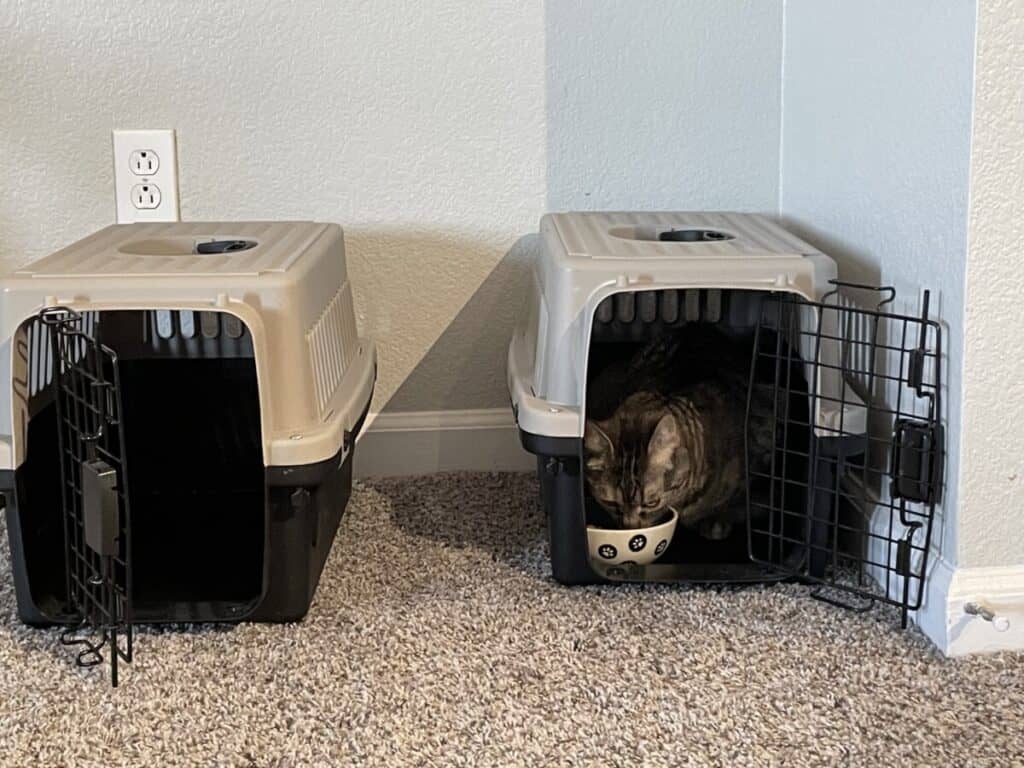
2. Start With Short Trips in the Car
Once your cat feels comfortable in their carrier, start picking them up and closing the door. After some time, you can start walking to your car with the carrier and hanging out in the car with your cat for a few minutes at a time.
I have one very skittish cat, and when I went through this process with her, I made sure the car was started before I brought her out. That way she could get used to the noise of the car running without being startled by the engine her first few times in the car.
After a few times of doing this, start taking your cat on very short little trips. Go up the road and back down or drive around the block. After each trip, you can give your cat a treat or some food in their carrier to let them know they’re alright.
Starting with short trips like this is a great way to help reduce your cat’s travel anxiety on longer or frequent trips in the car. You’ll see more on reducing your cat’s travel anxiety later in this article.
3. Go to the Vet
Before you travel very far or very frequently with your cat in the car, make sure to check with your vet about your cat’s health.
Make sure your cat is up-to-date on any shots or vaccinations that are required. Additionally, check your cat’s microchip information and make sure it’s up-to-date. If your cat isn’t chipped, consider having that done before your car trip with your cat.
This vet visit will help you determine if you need to schedule any additional breaks for your cat, if you should consider any prescription sedatives for your cat before travel, and provide peace of mind.
4. Withhold Food Right Before Travel
While you’re at the vet, talk to them about withholding food before you travel with your cat in the car.
My oldest cat used to get sick every time she was in the car. It took a few car trips for me to realize that I needed to stop feeding her about four hours before we got in the car. Since I started withholding food before travel, none of my cats have gotten sick on the road.
Of course, every cat is different. If your cat takes medication with food, it may be unavoidable to feed them right before you get in the car. For this reason, I recommend asking your vet for their professional opinion beforehand.
If you are moving with your cat, be sure to check out my guide on what to do with your cat on moving day for more ways to prepare your cat for the trip.
Tips for Traveling With a Cat in the Car
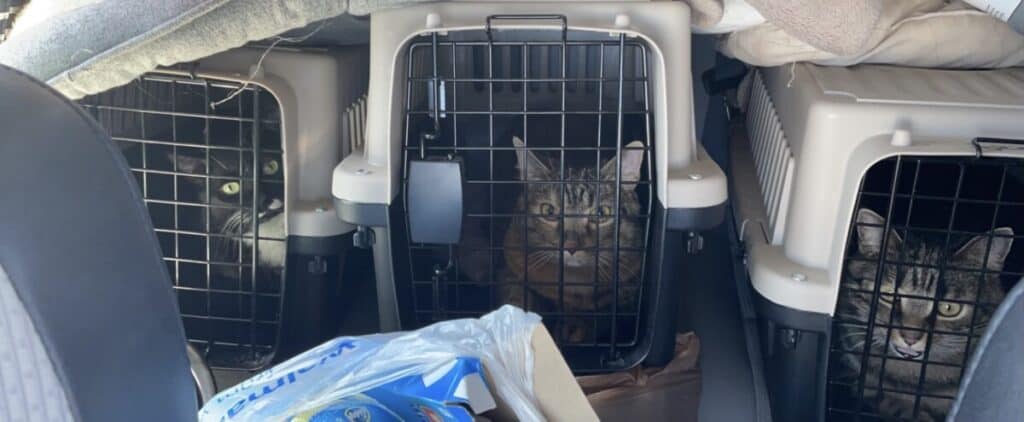
If you had a lot of time to prepare your cat for car travel, that’s ideal. However, it isn’t always the case. Either way, there are a few things that you can do in your car on the day of travel to help make the ride as pleasant as possible for you and your cat.
After traveling nearly 8,000 miles with my three cats over the past five years, here are the six best tips I’ve found for traveling with a cat in the car:
- Create a comfortable, safe space. Hopefully, your cats feel comfortable in their carrier. It should be big enough for them to stand, turn around, and lie down. You’ll also want to put your cat in the car in a place where it will be safe. Make sure your cat’s carrier will stay in place and be out of line from direct sunlight or air conditioning.
- Use a pheromone spray. One way you can create a safe, comfortable space for your cat while reducing travel anxiety and meowing on the road is by using a pheromone spray. My veterinarian recommended Feliway (you can buy it on Amazon) and we love it.
- Have your essentials nearby. To make your trip as smooth as possible, make sure you have everything your cat will need nearby. Think of it like a kitty diaper bag. Pack a couple of familiar toys or a blanket to help reduce anxiety. Pack a travel water and food bowl (along with food and water) plus a travel litter box, litter, and a scoop. You may even want to pack some calming cat treats for the road.
- Take breaks regularly. Speaking of a travel litter box, make sure you give your cat a chance to use it if you’ll be on the road for very long. Even if your cat doesn’t use the litter box, eat, or drink, you should still give them a break from their carrier every few hours.
- Prepare for accidents. Even if you do take regular breaks with the opportunity for your cat to use the litter box, they still may have an accident in the car. Your cat may pee nervously or even get sick. For this reason, it’s a great idea to bring puppy pads and line your car seats or cat carrier just in case, especially the first few times you travel with your cat.
- Check-in on your cat regularly. This one may seem obvious, but touch base with your cat while you’re on the road. If they’re panting a lot (learn more here) or getting sick, it’s time to pull over. If they’re meowing, they may need to be petted for reassurance if you can do so safely.
How To Travel Long-Distance With a Cat
If you’re going to be in the car with your cat for an extended period of time, there are a few more things you can do to prepare.
Compared to taking your cat in the car for a visit to the vet or on a short weekend trip, something like moving across the country is a bit of a different trip.
Here are three things I made sure to prepare for in addition to the tips listed above:
- Pet-Friendly Hotels & Car Rentals. If you’ll be staying overnight on the road or using a car rental company for any part of your trip, you’ll want to verify that they’re pet-friendly first. I recommend picking a few different pet-friendly options in the destination of your choice and calling around to get quotes on the best rates.
- Planned Breaks. If you’re going to be on the road for four or more hours, you should consider planning a break for your cat. It might work out to just take breaks at gas stations/truck stops along your path, but you may also want to check the map ahead of time to see where the best (and perhaps least-busy) stops will be along the way.
- Travel Litter Box & Food/Water Bowls. For longer trips, your cat may need a litter box break or some water. While your cat may choose not to use the litter box or eat until you reach your destination, you should give them option. Check out my top picks for the best travel litter boxes along with these tips on how to travel with a litter box in the car. Also, consider getting a set of travel food and water bowls for your cat before your trip (see my top picks here). When it comes to travel litter, food, and water, I recommend just packing a bit of what’s most familiar to your cat already.
Additionally, be sure to let your veterinarian know that you’ll be traveling a long distance with your cat.
Especially for trips like these, your vet may prescribe a mild sedative for the trip. They may also recommend more frequent breaks or other best practices based on your cat’s health, age, and personality.
For more tips and information on traveling long-distance with your cat, check out my full guide to moving across the country with a cat.
How To Reduce Your Cat’s Travel Anxiety
Most cats will experience travel anxiety the first few times they’re in a car. Some cats may get travel anxiety every time they’re in the car. That’s normal.
While you may never be able to completely eliminate your cat’s travel anxiety, there are a few things you can do to help reduce it.
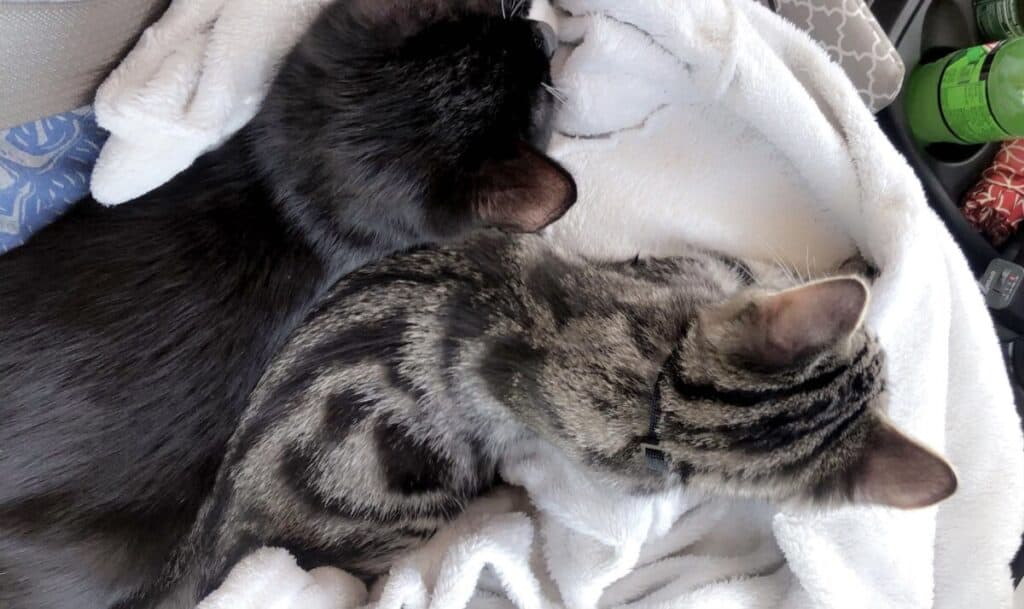
After traveling with my cats in the car for thousands of miles, here are the best tips I’ve found for reducing your cat’s travel anxiety:
- Get your cat used to their carrier and the car. I mentioned this earlier, but it’s worth repeating. Get a good cat carrier as soon as possible and let your cat explore it on their own time. Start with short trips in the car to help get your cat used to traveling.
- Use a pheromone spray. I can’t recommend Feliway enough for traveling with cats in the car. It’s a great pheromone-based spray that’s veterinarian-recommended. In my experience, it really does help calm cats, especially in the car.
- Surround your cat with familiar smells. You can bring your cat’s favorite blankets and toys in the car with you to surround them with familiar smells. This is a great way to help your cat feel safe and calm in a stressful situation.
- Check on your cat regularly. You can help reduce your cat’s travel anxiety by checking in on them and making sure they’re comfortable. If they’re panting or meowing a lot, they may need a break from their carrier, the litter box, or some water.
- Use calming treats or sedatives. You can find tons of highly-rated cat calming treats on Amazon. Additionally, you can talk to your veterinarian about whether or not your cat needs a prescription sedative to help calm their travel anxiety on the road. In the past, my cats have been prescribed small doses of gabapentin.
Why Is My Cat Panting in the Car?
As I said at the beginning of this article, it’s no surprise that many cats are not a fan of car rides. In fact, many cats will be quite vocal about not enjoying the ride. But when should you start getting concerned?
Speaking from first-hand experience, I know how alarming it can be when your cat starts panting in the car. However, this is actually a common response for cats in stressful situations, like being in a moving vehicle.
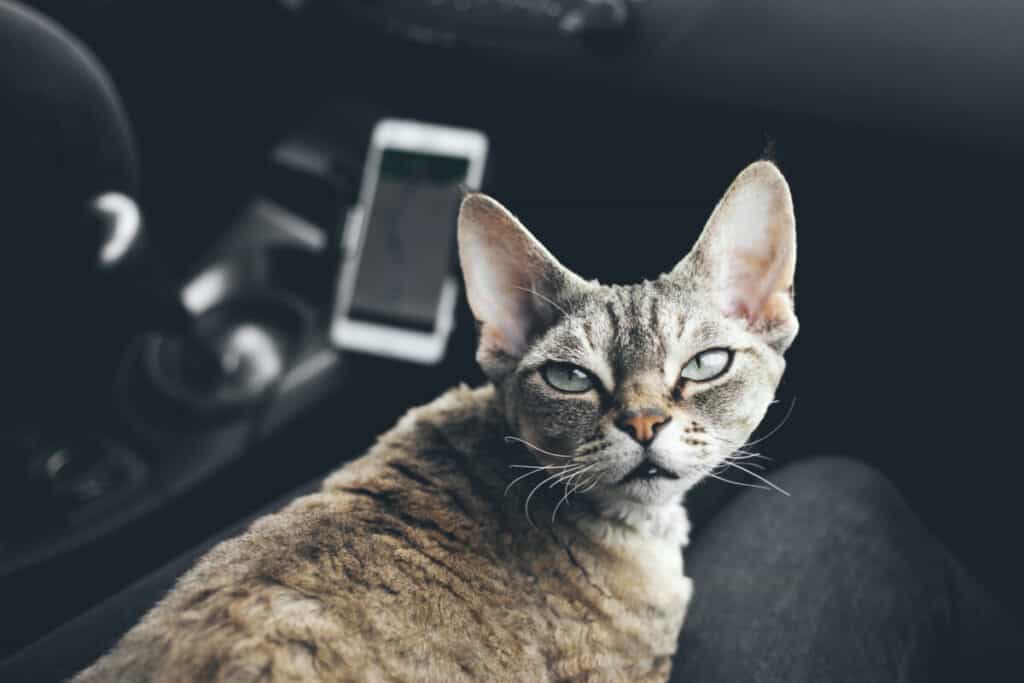
The most common reason that your cat is panting in the car is simply that they’re stressed or anxious. Traveling is stressful for cats unless they’re used to it. Especially the first few times you travel with your cat in the car, you may notice them panting.
In addition to anxiety, reasons for your cat panting could include that they’re too hot. Just make sure their carrier has proper ventilation and that they aren’t sitting in direct sunlight the whole trip.
There could be underlying medical conditions that your cat is panting in the car including allergies, asthma, respiratory infection, or heartworm to name a few. However, if they’re panting for these reasons, you won’t just notice it in the car.
For more on why your cat is panting in the car and how to help calm them, check out this article.
The Best Cat Carriers & Other Cat Travel Essentials
If you’re getting ready to take your cat on a road trip, one of the first things you’ll need to do is select a cat carrier. The earlier you order your cat carrier, the more time your cat will have to warm up to it before the day of the drive.
I’ve researched dozens of cat carriers across several popular brands and styles. Based on my research, here are three of the best cat carriers available right now (with links below each to check the current price and to see more options):
Best Cat Carrier for Two Cats
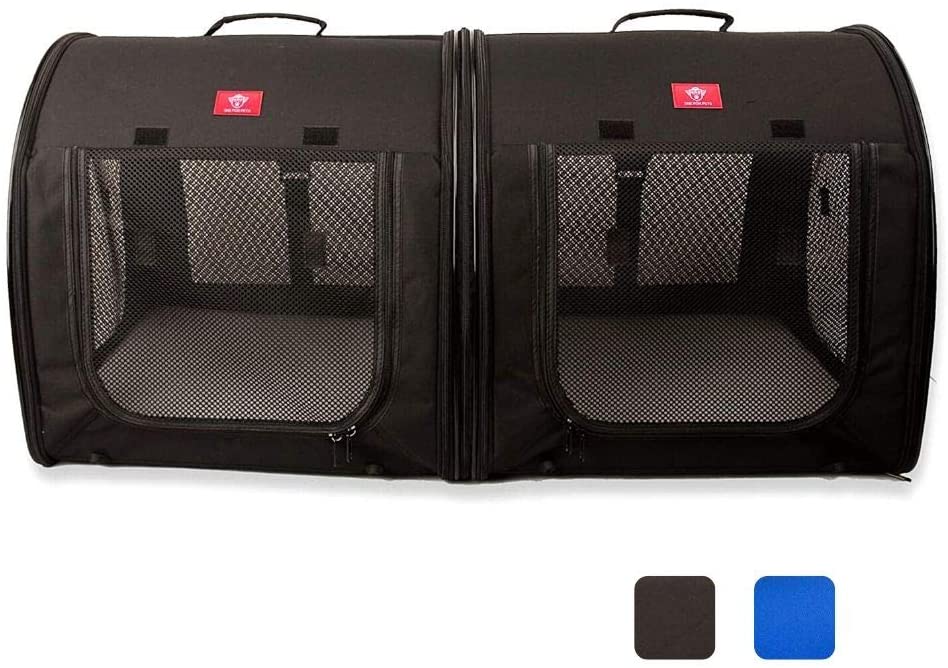
One for Pets Portable 2-in-1 Double Pet Kennel
Best Cat Carrier With a Litter Box
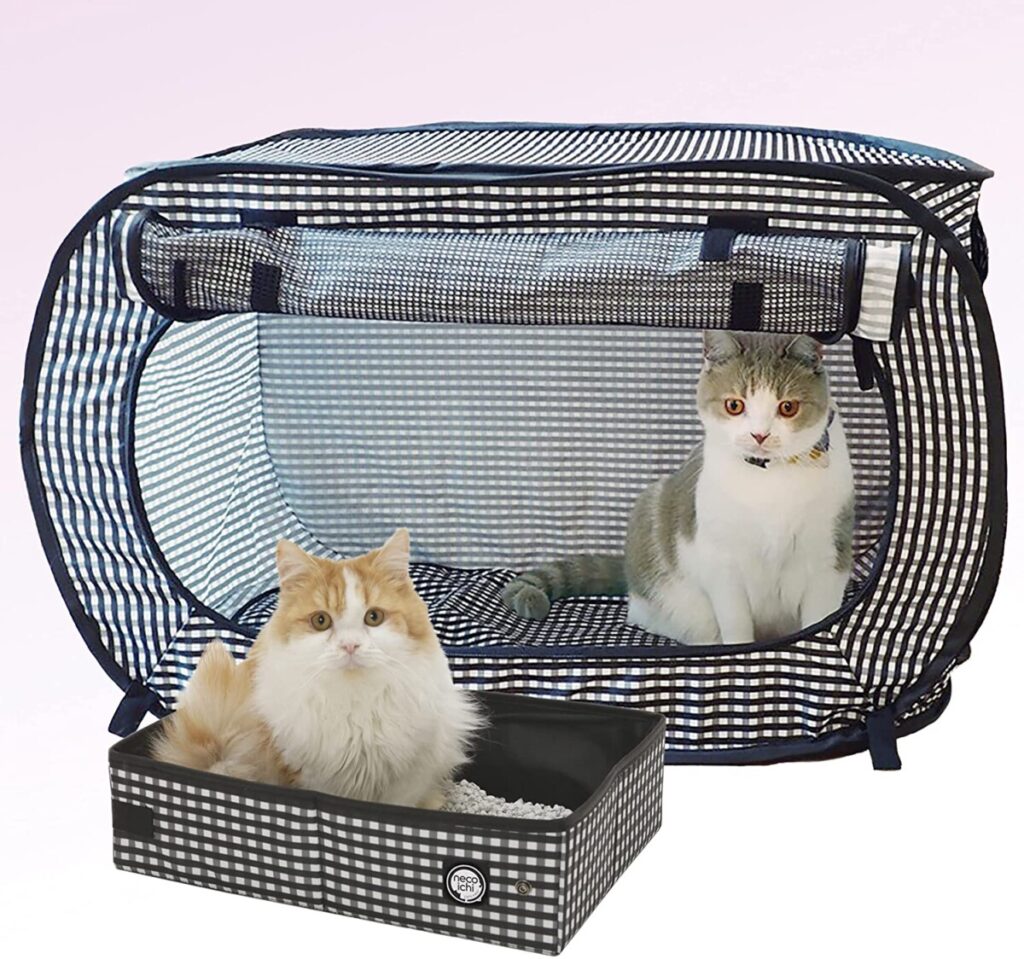
Necoichi Portable Stress-Free Carrier
As you begin shopping for the best cat carrier for yourself and your cat, keep in mind that you’ll need something with proper ventilation, enough room for your cat to comfortably lay down, stand up, and turn around in, and that meets the needs of your trip.
In addition to a solid cat carrier, there are a few other travel essentials that you may want to purchase before the trip. Here are my recommendations:
- Travel food and water bowls (see my top picks here)
- Portable litter box (see my top picks here)
- A harness (this one is very highly-rated)
- Pheromone spray (I definitely recommend Feliway)
I recommend introducing any new products that you purchase in preparation for your car trip with your cat to them at home first. The trip car ride will likely be new and frightening for your cat. If you can get them familiar with their essentials ahead of time, they’ll be less reluctant to use them on the road.
For more tips on how to travel with your cat in the car, check out these helpful articles:
- How To Travel With a Cat Litter Box in the Car
- How Long You Can Travel With a Cat Before Needing a Break
- Why Is My Cat Panting in the Car?

